Summary
Instructor Sherena Hussain (former Assistant Professor) explains how she makes introductory infrastructure course PROP 6300 Partnership Models for Infrastructure Delivery a high-impact learning experience by incorporating an experiential capstone project in which students work on challenges currently facing the industry. Just as infrastructure continues to evolve, so too has the course design and the issues that students must grapple with. Students come away from the course with the tools to understand and analyze different delivery models as well as with experience interacting and networking with leaders in the industry.
Video Transcript
Prop 6300 is an introductory course to infrastructure. We start with the elementary question of “what is infrastructure?” which in most cases, most of us do not even know what that is. And then we take it one step further exploring it as an asset class, and then diving into the challenges of what partnership models exist around the world to deliver new infrastructure. Not just here in Canada, but also around the world.
As a student here at the Schulich School of Business, there are at least three reasons why you should treat infrastructures as being important: First, infrastructure is critical to our daily lives and is a linchpin for productivity growth around the world. Second, infrastructure increasingly is a growing financial asset class. If you want to understand growing capital flows, you need to understand infrastructure at the very least. And third, there’s a need to understand infrastructure as being part of the solution to deal with the broader sustainability challenges we have around the world.
If we want to reduce greenhouse gas emissions as an example, often a solution is tied to our transportation networks. It’s also tied to the type of energy we generate. If we all want to get up one day and start driving electric vehicles, do we have the electrical grid to support that? Is it going to generate clean and sustainable energy? For that reason, trying to achieve broader sustainability goals, like reducing greenhouse gas emission, is heavily tied to making sure the right infrastructure is in place to facilitate that.
This class is much more than a development class. It takes the theory one step further and is experiential at its core. Because infrastructure is evolving in real time, so too has course delivery, and this is in the form of having students grapple with key issues. Students debate and are immersed with industry leaders on a real-time basis. And finally, the course comes together in the capstone project in which the students are dealing with a challenge that must be addressed, whether here in Canada or abroad.




Many students are blown away by the capstone project in the sense that it requires them to think about something quite challenging. How do you deliver near zero, or zero emission infrastructure in a place that’s so heavily dependent on emitting transportation like Ontario? Or how do you then deal with international infrastructure? In many ways, the challenge can be daunting, but students have the tools over the course of their semester to start thinking about different delivery models. In many ways they’re very appreciative of the opportunity to not only go to complete the exercise but also to interact with some of the leaders in the industry, who provide them real-time feedback, a network and a positive impression of career opportunities available to them, all in the context of this one course.
In the past I’ve had students get hired out of that presentation on the basis that the students were able to command the stage, but also to impress the series of senior government officials as well as industry professionals who are there to offer their constructive feedback. Time and time again, as alums, students come back and tell me this course was one of their highlights and on the basis of a lot of the opportunities they got out of it including the experiential notion of this class allowed them to reflect positively about their experience at Schulich.


